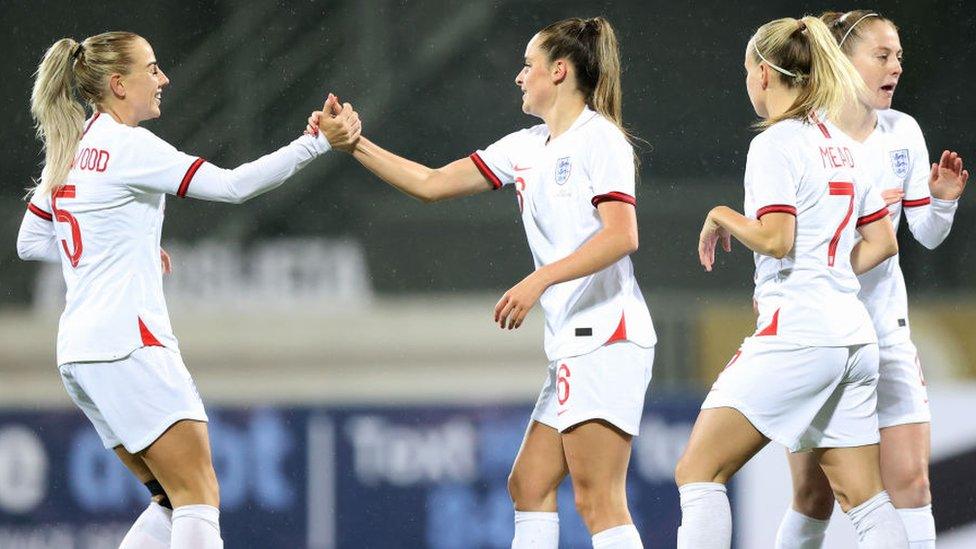Women's World Cup qualifiers: How are the home nations getting on?
- Published
- comments

England's Lionesses have scored a whopping 32 goals and conceded NONE in their last four matches!
England racked up another impressive World Cup qualifying performance on Tuesday, scoring an amazing 10 goals against Latvia.
Manchester United forward Ella Toone opened the scoring early in the match, going on to earn her first international hat-trick in only her third appearance in an England shirt.
"It's been a special night and a very proud moment for me and my family," she said after picking up the player of the match award.
The win means the team have maintained their 100% qualifying record (four wins from four matches) and have scored a whopping 32 goals in that time.
A hat-trick for Ella Toone meant she took home the match ball.
If they continue this form, they will be one of the favourites for the ultimate prize at the 2023 World Cup in Australia and New Zealand.
England manager Sarina Wiegman called Toone "a very talented player" and added: "I don't know how good she will become - that's up to her. But she's really talented, that's obvious. I'm very happy she got this hat-trick."
The other scorers on the night included Ellen White, who rose to joint second overall in the list of the nation's top female goalscorers. She nabbed her 44th goal, but missed out on her 45th after her penalty was saved by Latvia's keeper Enija Anna Vaivode.
Elsewhere, Wales beat Estonia 4-0 in front of a record crowd in Cardiff.
More than 5,400 people cheered on the team as Angharad James, Helen Ward, Natasha Harding and Sophie Ingle's goals sealed victory.
Wales' Sophie Ingle celebrates sealing her side's 4-0 victory in Cardiff.
Wales' women have never qualified for a major tournament, but have made a promising start to their bid to be at the World Cup in 2023.
Northern Ireland were denied victory by Austria's injury-time equaliser, but will have another opportunity to beat the tricky opponents next Spring.
The 2-2 draw means they remain in third place in group D, behind Austria and England, with only the top team gaining automatic qualification.
It finished all-square between Austria and Northern Ireland in Belfast.
They must finish second in the group in order to reach the play-offs, giving themselves another chance to qualify for the tournament.
Scotland won't play again until next month. They face Ukraine on 26 November followed by a tough game against Spain four days later.
The qualifiers will run until 6 September 2022, with each team playing a total of eight group stage matches.
When is the Women's World Cup and how does it work?
Scotland took on Hungary in their last qualifier, beating their opponents 2-0
The European qualifying group stage for the 2023 Women's World Cup is currently underway.
51 teams have been split into six groups of six teams, and three groups of five. They're competing to gain one of nine direct spots in the World Cup finals which takes place in Australia and New Zealand from 20 July to 20 August 2023.
The teams play everyone in their group, with the winners going straight through to the finals.
The runners-up in each group will get the chance to take up two remaining spots in the play-offs which take place in October 2022.
Wales won their fist qualifying match against Kazakhstan last month
As well as the European group stages, there will also be qualifiers taking place in Asia, Africa, North America, Central America and the Caribbean and South America. Teams in these regions will be competing in their various leagues to earn one of 16 places in the World Cup final.
As the competition's host nations, Australia and New Zealand will both have a guaranteed spot in the final.
A ten-team tournament, known as the inter-confederation play-offs, will be held in Australia and New Zealand from 17 to 23 February 2023 to decide which teams get the final three slots in the competition.
There will be a total of 32 teams taking part in the competition's final.
Who won the last Women's World Cup title?
The USA won the last tournament
The USA beat the Netherlands at the last Women's World Cup in 2019.
The team have won the title a record four times and will be looking to gain a fifth win at the next tournament.
Are you looking forward to the Women's World Cup? Who are you supporting? Let us know in the comments!
- Published8 July 2019
- Published7 July 2019
- Published7 July 2015
